Anchors: What to Consider when Buying or Replacing an Anchor
If you are considering buying a new anchor or changing or replacing your existing one, there are some important issues to consider as outlined in this latest article from Jimmy Green Marine.
Published 1 year ago
If you are thinking about replacing your anchor, be sure to assess why and what you are trying to achieve, because there will be some important decisions to make:
- Straight Replacement or Upgrade?
- Hot Dip Galvanised or Stainless Steel?
- What Size Anchor Do I Need?
- Which Manufacturer or Model Should I Choose?
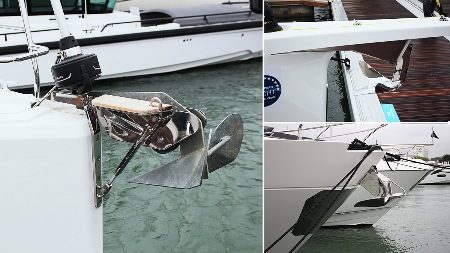

And there will be more parts of the equation in the mix before you can make your final choice:
- Budget
- Performance Requirement
- Bow Roller Compatibility
Straight Replacement or Upgrade
The answer stems from the reason you have decided to change.
Is your existing anchor simply too old or too rusty?
Anchor design has moved on significantly this millennium. Still, you may be perfectly happy with the performance of your current anchor, even if it is one of the older designs like the Bruce or the Delta.
Walking around a marina, you will see plenty of these old stalwarts at the bow of motor and sailing yachts. The originals are either readily available (Lewmar Delta), or if not, there are reasonable copies (Lewmar Claw for the Bruce). You could find your local galvanising works and ask how much it would cost to re-galvanise, but the new versions are very reasonably priced compared with more modern designs, and they are available in stainless if you really want to push the boat out.
If you are not hugely reliant on anchoring for your sailing activities and have not experienced any problems, stick with what you know, with the added bonus that it will dovetail back into your anchoring setup without any problems.
Is it a little undersized? Or oversized, for that matter?
Anchor manufacturers usually have a weight guide according to the length of your boat. The more prominent manufacturers tend to include extra factors such as displacement, windage and wind speed for a more comprehensive recommendation. Of course, it will also come down to how much anchoring you do and how much you depend on it.
The advantage of replacing like for like, even in a size up or down, is that there will be a good chance it will fit and work over your bow roller.
Have you dragged the anchor or experienced any other anchoring issues?
This is where you must think about which anchor design will suit you best.
Are you planning an extended cruise?
There is a world of difference between a quick foray out and back on the tide with a bite to eat at anchor in a sheltered bay and a liveaboard ocean cruise when anchoring will be paramount to the welfare of you and your crew.
Galvanised or Stainless Steel
Hot Dip Galvanising is still the most prevalent finish for anchors on motor and sailing yachts because stainless is much more expensive, making it less of a priority in the overall yachting budget for most skippers and owners.
Hot Dip Galvanising is more than just a sprayed-on or painted-on surface treatment like cold galvanising (also known as electroplating). Hot Dip means dipping in molten zinc, which results in the zinc being infused deeper into the steel. The abrasive action of the seabed on an anchor naturally involves continual degradation, but the effect should be gradual, giving multiple seasons of service. The deterioration will eventually lead to rust stains, which will, in time, develop into rust.
Galvanising: the treatment process explained
When you position your anchor on the bow roller, exposed to the salty elements, the oxidisation and corrosion will start. So, stainless steel may be your best option if you value a rust-free anchor at the stemhead.
Stainless also has the advantage of clearing itself of mud and debris more readily than galvanised. It is important to realise that staining can occur on stainless steel, despite the implication, but specialist cleaning agents are available to restore your anchor to pristine condition. They are generally simple to apply with no need for scrubbing or polishing.


There are specialist stainless steel anchor designs available or stainless versions of many of the well-known galvanised anchors. One note of caution: from an engineering point of view, it could be argued that an anchor should be purpose-designed for their intended metal because mild steel and stainless steel have different strength properties.
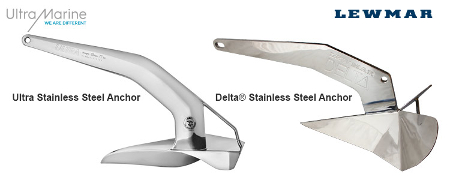

Combining Galvanised with Stainless in your Anchoring System
Joining the two different steels is a widespread practice. Stainless steel shackles and connectors are commonly used to join a galvanised chain to a galvanised anchor, apparently successfully, but a routine check will give you peace of mind.
Hopefully, everybody knows that mixing the two can cause galvanic corrosion. Stainless is the nobler metal, so the deterioration, i.e. the rust, will normally affect the galvanising.
The effect is exacerbated when a stainless anchor is joined to a galvanised chain with a galvanised shackle because of the relative mass. It is usually less of an issue when a large, galvanised anchor is connected to a relatively small stainless-steel shackle.
Keeping the same steel throughout is best if you do not want to take the risk or be bothered with the maintenance.
What Size Anchor Do I Need?
Your anchor size should be based on your chosen anchor design, yacht length, displacement and windage. Each manufacturer will publish a guide to interpret for your individual requirements.
At this point, the extent to which you will depend on your anchoring setup to safeguard your yacht in extreme weather should greatly influence your decision. Your anchor, chain, and all the components of your anchor rode may be required to save you from a lee shore disaster.
The usual method, which is fine for most anchoring, is to interpret the manufacturer guide as best you can, listen to any available independent advice, and go with the consensus. The argument for upgrading to a larger size for global cruising is compelling if you can accommodate it at the bow and it falls within your budget.
One note of caution, though: make sure that the rest of the anchor rode (the chain, rope and connections) is compatible in terms of strength and that the windlass has the power to retrieve the extra weight.
Which Manufacturer or Model Should I Choose?
Do Some Research to Draw Up a Shortlist
This article is aimed at how to tackle the job of purchasing the best anchor for you, not at recommending any specific anchor. Look online to learn about all the modern design anchor options. There are plenty of anchor reviews and comparison tests you can access on the internet, bearing in mind that they may not be entirely independent.
The best advice is to do your research, watch some videos, and take note of the perceived advantages and disadvantages that the reviewers put forward, remembering that all their opinions are subjective.
Take into account that anchor tests may not replicate your real-life experiences, so think about features that are most important to you, for example:
- Break-out reliability
- Self-setting capability
- Holding power in your typical seabed
- Ability to hold or reset and hold during big tide and wind shifts
- Mud and debris shedding capability
- Retrieval in the right orientation into the stemhead
- Whether a roll bar works with the existing deck layout
- Aesthetic appeal, rust-free finish
Roll bars are designed to make the anchor land the right way up to set, but they are large features that may prove awkward to work around. In contrast, more recent designs can achieve the same ‘roll and ready to penetrate’ attributes with advanced geometric design, weighted tips and lighter shanks.
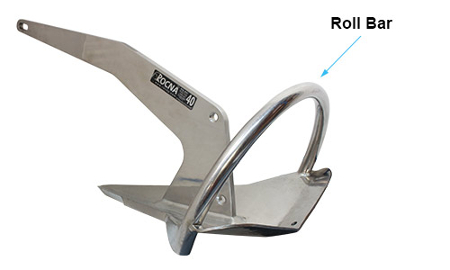

With a bit of luck, this will give you some ideas and enable you to narrow down the options. From there, you need to move on to the other main considerations:
- Budget
- Performance Requirement
- Bow Roller Compatibility
- Purchase Planning
Budget
Use your online research to compare the prices of the anchors on your shortlist by recommended size. This should help to zero in on some preferences. There are extremely expensive anchors available, especially in stainless steel. Some options may simply be too much money for what you need. Pick your wish list according to how much you are prepared to spend.
Performance Requirement
Use your anchoring experiences as a benchmark to decide what you want to achieve. Has your anchoring been stressful in the past? What issues did you experience, e.g. unsuccessful setting attempts, dragging, retrieval or stowage issues? Factor in the results of your research to estimate the likely improvements your favoured options will make.
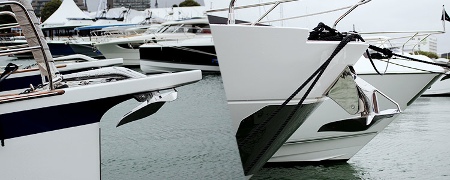

Bow Roller Compatibility
Last, but certainly not least, is whether any of your chosen contenders will fit your stemhead without any alteration to the design or negative effects on your existing deck layout. You should also consider any planned alterations or upgrades, such as adding a bowsprit and top-down furler, because these may impact your decision.
In some respects, this is the tricky bit. Upgrading to a totally different anchor design may make it difficult to assess whether it will fit.
Top manufacturers should be able to provide single-plane, actual-size paper or cardboard templates through their principal retailers, giving you a fairly good idea of whether their anchor will be suitable.
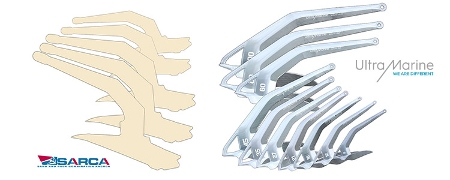

The manufacturer may also have a database that records compatibility for popular yacht models – N.B. if they have not been altered from the original specification. However, this will not cover three-dimensional sizing. Roll bars can also be problematic depending on the configuration of the bow fittings, e.g. the route of any lines led forward to a bowsprit.
Ideally, you can look around the marina for an example that helps with a particular measurement or other peculiarity. It is even better if one of your neighbours lends you their anchor to try out on your boat. It is definitely worth an ask. Just remember to reconnect it securely to their anchor chain!
Ultimately, to make absolutely sure your preferred anchor will be suitable, you may have no option but to purchase it to try.
Purchase Planning
Price will be a key factor, but buying the cheapest is not always the best solution, even in a like-for-like comparison, especially if you think you will be happier with the customer service at a slightly higher price.
Choose your dealer based on reputation and trust so that you are confident in their ability to take care of any warranty issues that may occur down the line. Buying from a dealer specialising in anchoring rather than a general chandler could be the way to go. For one thing, they are far more likely to have your chosen anchor in stock, which will make it much easier for them to answer any questions or make a final measurement check.
If you are still not 100% certain that the anchor will fit, check the returns policy, and even better, contact the dealer to gauge their attitude toward the possibility of a return.
One final word of caution. Take the utmost care not to scratch or mark the anchor when trying it on the bow roller. This will, quite rightly, adversely affect your right to return it.
Summary Checklist – 8 Basic Steps to Buying an Anchor
- Choose between a straight replacement and an upgrade to a fresh design.
- Consider whether you want Galvanised or Stainless Steel.
- Do your research into the available manufacturer models.
- Check what size anchor you need from the manufacturer’s guides.
- Decide on your budget.
- Make a list of your most important performance criteria.
- Check the compatibility with your bow roller and forward deck layout.
- Buy from a dealer that you trust.
…………………………


About the Author
Jimmy Green Marine is a family-run business founded by brothers Alistair and Mike Green, based in the coastal fishing village of Beer in East Devon. The company started as a Mail Order Chandlers in 1981 and has continually evolved from attending Boat Shows and Boat Jumbles in the early days to now trading globally online.
Four decades of exporting experience combined with an intuitive website shipping calculator means that you can have your order delivered to your home, business or direct to your yacht anywhere worldwide.
Their flagship, innovative Custom Build website system provides an instant quote for all your professionally spliced and finished wire and rope rigging, mooring and anchoring solutions.
You can access this online from wherever you can get an internet connection, however remote.
Alistair Green is an experienced sailor and rigger with over 40 years of experience in the marine industry. He is passionate about providing his customers with the best possible products and services and is always looking for new ways to improve the business.
If you are looking for a reliable and experienced marine supplier, then Jimmy Green Marine is the perfect choice.
Visit their website today to learn more about their products and services.
…………………………
Related Links:
- Jimmy Green – What Size Anchor Do I Need?
- Jimmy Green – Galvanising: The Treatment Process Explained
- About Jimmy Green Marine
- Custom Splicing, Rigging and Sewing Service
- Worldwide Shipping
- Jimmy Green Marine joins Noonsite.com as Official Ropes and Rigging Partner (April 2023)
Other Articles by Jimmy Green Marine:
- Bridles – Extolling the Virtues of V-Shaped Bridles (December 2023)
- Mooring Lines – Horses for Courses (November 2023)
- When to Replace your Standing Rigging (October 2023)
- Ten Reasons to Whip and Stitch Your Ropes (September 2023)
- How to Choose your Next Anchor Chain (August 2023)
- How to Choose a New Halyard (July 2023)
- The Uses and Benefits of Rope Splicing Onboard a Yacht (May 2023)
………………………………
The opinions expressed in this article are the author’s own and do not reflect the view of Noonsite.com or World Cruising Club.
………………………………
Find out all news, reports, links and comments posted on Noonsite, plus cruising information from around the world, by subscribing to our FREE monthly newsletter. Go to https://www.noonsite.com/newsletter/.
Related to the following Cruising Resources: Equipment, General, Planning and Preparation



